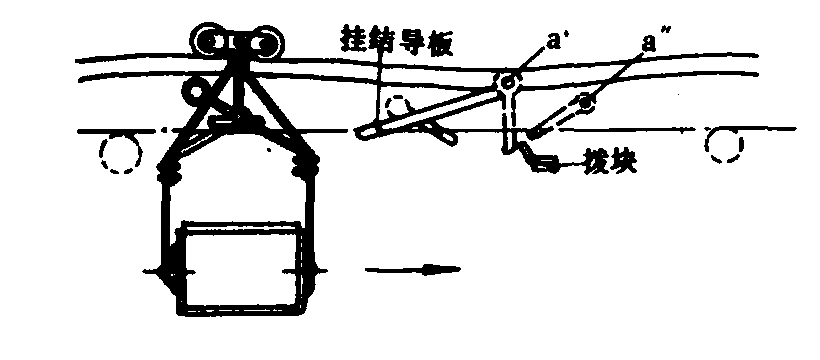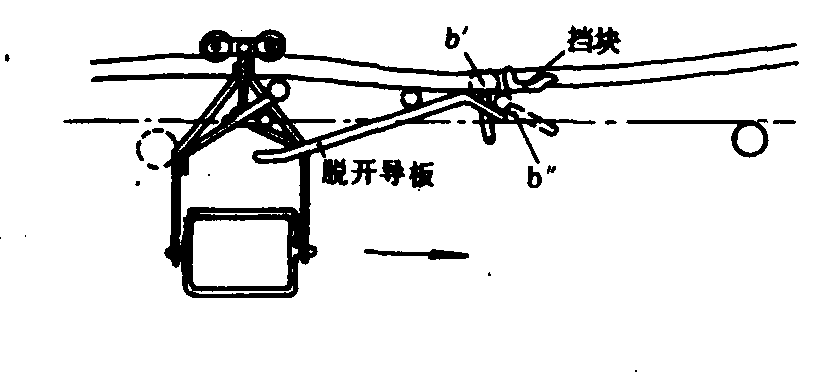架空索道overhead cable way
用架空的钢索承载,在两定点间运输物料的设备,简称索道。适用于丘陵山区短距离运输。索道对复杂地形的适应性好,可以跨越山涧、溪流、梯田等。它施工量小、建设快、装卸物料简单,操作容易。但只能做集中定点运输,机动性差。农业常用的索道有双线往复式、自走绞盘机单跨式和双线循环牵引式等。
双线往复式索道 有简易单跨式和动力驱动多跨式两种。
简易单跨索道 特点是架设方便,设备投资少。但运量小、运距短,多用于农田建设。其构造和工作过程如下:两条平行的承载索由两个支架悬空架起、张紧,两端锚结在地上。两个运料斗车悬吊在上、下支架内的承载索上。牵引索的两端与斗车连接,中间绕在高处支架的绞盘上。装物料的斗车利用重力由高处沿承载索滑下,通过牵引索和绞盘带回另一条承载索下的空斗车,如此往复运输。绞盘上设有制动装置以限制滑行速度,高度差不大时可不设制动装置。卸料地点由停车止动装置或料斗自动打开装置控制。承载索可用竹索或6~8毫米的钢条,单跨距离一般在40米以内,包括斗车自重在内的载重量为20~30千克。如果用钢丝绳做承载索,则跨度和载重可适当增加。
动力驱动多跨索道 属半永久性设备,投资较多,架设支架、安装绞盘机要打基础。用于农田建设和农业运输,其结构与单跨索道相似。承载索一般直径为20~30毫米的专用钢丝绳,长度可达1 000米,支架较多,每跨距离依地形而定,由几十米到二三百米。每个支架上有托轮,托住承载索。牵引索是长环形的钢丝绳,环的一端绕在绞盘机的绞盘上,另一端绕过两个转向和张紧的滑轮,两侧边由支架的下横梁托起,并在上、下两端的支架内分别与斗车连接。绞盘机由电动机或柴油机驱动,带动牵引索拉着运料斗车上、下往复运动,行驶速度约2.5米/秒。绞盘机的离合及制动装置控制斗车速度。料斗载重量200~300千克。
自走绞盘机单跨式索道 承载索运行式的索道,如图1。以中型轮式拖拉机为动力,适于在20°~35°

图1 自走绞盘机单跨式索道
的坡度、距离300~500米的条件下运输。这种索道架设方便、移动速度快。除用于农业运输外,还广泛用于林业集材作业。它的牵引索和回空索常用直径8毫米的钢丝绳,绷绳用直径15.5~18.5毫米的钢丝绳。绞盘机的两个卷筒均为缠绕式,牵引力一般为20~30千牛。跑车及回转轮均采用3吨载重能力的滑车。跑车下或牵引索端可挂料斗或夹具等。运输时,分别收、放两卷筒的钢丝绳,可使跑车行驶到装料地点;放松钢丝绳使跑车下面的料斗下垂到离地面0.5米以下,以便装料;最后收紧钢丝绳使料斗升至适当高度悬空,两卷筒的同步器使进、出的钢丝绳保持同一运行速度运输。当运输较长木材并且重量超过1吨时,应使木材一端悬起、另一端呈拖地状态运行。如果没有同步器只要司机熟练也可运行,及时调整各卷筒速度使两根索保持相近的垂度,这时运行状态木材悬吊端呈上下起伏。双线循环牵引式索道 多料斗循环运行山上、山下两点之间的永久性设备(图2)。适于常年运输,运距为1~3千米,生产率较高。其构造和工作过程如下:由两根平行架空的承载索和两端的架空钢轨构成循环承载系统。承载索由支架上的支承鞍座或托轮架空,张紧后与地面锚结。驱动轮始终以一定的转动方向和每秒1米的速度驱动循环索(整圈闭合式牵引索)。在循环索回转轮上连着重锤,保证循环索在一定张力下运行。夹索器使跑车与循环索挂结或脱开。空跑车在装车站台装车,装满后将跑车推至重车承载索并与循环索挂接,跑车被牵引到卸车站台与循环索脱开,在卸车站台卸车。卸货完毕后将跑车推到空车承载索重复牵回。

图2 双线循环牵引式索道
1.架空钢轨(卸车站台);2.重载跑车;3.支承鞍座;4.重车边承载索;5.架空钢轨(装车站台); 6.站内支架; 7.支承托轮;8.驱动轮; 9.空跑车; 10.支架;11.空车承载索; 12.循环索回转轮; 13.重锤
跑车 承载索上悬吊的载货装置,依夹索器的不同有多种类型。常用的有螺旋式夹索器跑车,适用于索道平均坡度在20°以下;重力式夹索器跑车,适用于索道平均坡度在20°~38°。
螺旋式夹索器跑车,主要由螺杆、滚轮、摇杆、夹钳、吊架及螺旋式夹索器组成。夹索器安装在跑车的吊架上。夹钳的左、右两片钳口装在螺杆上。左钳口带有左旋粗螺纹,右钳口带有右旋细螺纹。在螺杆端部的摇杆上装有滚轮。当跑车进、出站口时,滚轮沿挂结导板或脱开导板滚动,从而使摇杆和螺杆一起转动。螺杆转动很快地向循环索靠近,开始接触循环索时钳口就停止不前。摇杆继续转动时,右钳口继续缓慢向内移动,并以很大的压力将循环索压紧在已停止不动的左钳口上。当摇杆向相反方向转动时,两钳口向相反方向移动放开循环索。
螺旋式夹索器夹索与脱索控制机构与工作过程如图3所示。夹索过程:首先人工将跑车推到夹索导向装置处,那里的架空钢轨有一定的倾斜度,以便使跑车的速度能增大到和循环索的运行速度相同。夹索器摇杆上端的滚轮沿挂结导板上升,顺时针转动到垂直位置a′时,夹钳开始和循环索接触、跑车继续运行,摇杆铰轴下端悬臂与拨块相碰撞后滚轮迅速滑落,以顺时针方向转到a″的位置,这时循环索在夹钳中被很大的压力压紧。夹钳螺母的细螺纹有自锁作用,因此夹钳的夹持力可保持不变。脱索过程:当摇杆上的滚轮行驶到脱开导板上,摇杆反时针转动到b′,此时滚轮继续向前运行而受挡块阻挡使摇杆反时针转,倒向左边b″位置,这时夹钳全部张开与循环索脱开。


图3 螺旋式夹索器夹索与脱索
架空索道
载重小车沿着布设在空间多支承的索道上运行的运输设备。具有能在较大范围内工作,对自然地形适应性强、受气象条件影响小等特点。分货运和客运、双线和单线、循环式和往复式等。
架空索道skyline system
一种集运材设备。由纹盘机、支架、承载索、跑车以及起重、牵引和回空索系统等部分组成。长距离的索道还须设置中间支架。其特点是载有木材的跑车在绞盘机的牵引索和回空索的作用下,沿承载索运行。它适用于地形复杂或坡度较大的伐区集运材作业。索道按支架数的多少分有单跨和多跨索道。按有无驱动机分有动力索道和无动力索道。按结构形式分有往复式、循环式、松紧式、承载索固定式、承载-牵引式和增力式索道。按作业目的分有运材索道、集材索道和装车索道。
架空索道
利用架空绳索支承、牵引客车(货车)运送乘客(或货物)的运输工具。随着钢丝绳出现,架空索道运输工具问世。1868年,世界第1条钢丝绳货运索道在英国苏格兰架成。1894年,意大利出现一条客运索道。1908年瑞士在阿尔卑斯山建成1条客运索道。1912年,德国在巴西建成一条完整的客运索道。德国1924年、日本1928年、苏联1946年分别建成一条索道。1982年,全世界客运索道2.3万条,欧洲1.7万条:其中奥地利3862条、法国3272条、意大利2494条、德国1806条、瑞士1541条。1975年美国1606条,至1985年3609条。1980年苏联建索道152条。索道按运行方式分:往复式和循环式。后者又分连续、间歇、脉动循环3种。吊具:吊椅、吊篮、吊厢、拖牵式。吊椅、吊篮容量有1、2、3、4、5、6人。吊厢30~80人。每时运200~600人。运速5~7m/s,最高12m/s。往返式索道,长不宜超过3km,离地高度8~15m、最大坡度100%。1989年,法国推出DMC(Doable Mono Cable)新型单线循环客运索道,保持了25年运量高的世界纪录。该种索道参数:吊厢容量20~30人、运速6m/s、水平长1900~4100m、高差395~880m、索径∅40.5mm、吊厢间隔时间20~40s、驱动功率2×450kW、每时运量3000人。世界著名的索道:1982年,奥地利Valisera索道,6人吊厢单循环。该索道分Ⅰ、Ⅱ区段,两区段参数分别为:水平长2128m和1948m、高差817m和465m、最大坡度103%和86%、行时7.1min和6.6min、运速5m/s、索径∅47mm、驱动功率2×660kW和2×350kW、运送能力每时2200人。1984年,美国Poma公司生产跨越密西西比河索道,吊厢6人循环索道,技术参数:水平长1025m、斜长1080m、最大跨度680m、距地最小高度55m、吊厢56个、行速5m/s、索径∅42mm、驱动功率440kW、每时运3600人、架高109m、总重120t、每侧托架32个、支架总荷载240kN。当代,已出现自行式客运索道,吊厢驱动装置在索道上,由驾驶人员操作行驶,在城市称为“空中客车”。客车离地5~6m,最大50~100m、坡度8%、线路跨度200~300m、电力驱动、时速35km/h,最大80km/h,车厢(吊厢)容量3种:80、125人和180人,相应每时运送能力,分别可达4000、7000人和10000人。